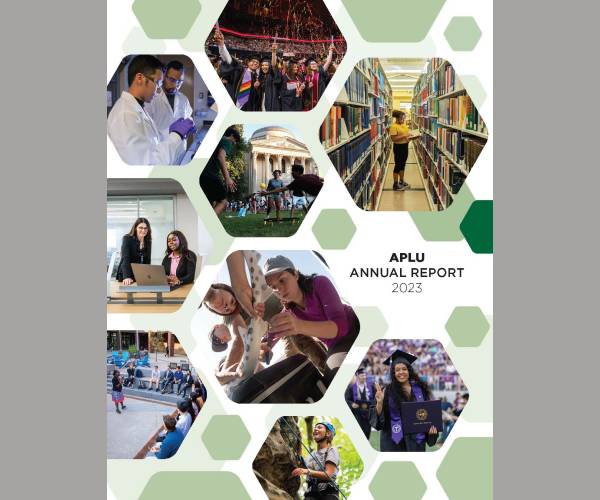Support Capital Infrastructure Investments at Colleges and Schools of Agriculture
- A 2021 Gordian study makes clear that unless the federal government moves quickly to address the growing funding gap for schools of agriculture, the United States risks falling behind on the world stage.
- Researchers and educators perform 21st century science and education in facilities constructed in the 1950s and 1960s. These buildings and facilities are at the foundation of our nation’s food, fuel, and fiber security and at the starting point of food and agricultural innovations.
- Every year, land-grant universities graduate more than 36,000 students in food, agricultural and natural resources disciplines.
 A Call to Support U.S. Agricultural Research Infrastructure
A Call to Support U.S. Agricultural Research Infrastructure
The land-grant university system serves the nation by fostering excellence in research innovation while providing avenues to train future global leaders in agriculture and food systems. The public extramural research enterprise accelerates technology adoption, growth of the agricultural and food marketplace, entrepreneurship, and public-private partnerships.
However, the land-grant university system faces unprecedented infrastructure challenges. More than 69% of research and education facilities at land-grant university colleges of agriculture are at the end of their life cycles. U.S. researchers and educators are being asked to perform 21st century science in facilities constructed in the 1950s and 1960s.
The Problem
Failing Infrastructure at U.S. Colleges of Agriculture
Modern agricultural research and education facilities serve as the backbone of cutting-edge research and applied science solutions that address climate change, agricultural profitability, food safety, zoonotic disease preparedness, personalized nutrition, biosecurity, new biobased packaging and energy innovations, and advanced market analysis. Gordian, a firm with more than 30 yrs. of experience analyzing cost data and planning services for buildings, evaluated current facilities at U.S. schools of agriculture for research, teaching, and Extension. In 2020, Gordian assessed the state of facilities at the colleges or schools of agriculture, reporting that 69% of the buildings are at the end of their useful life. Gordian reports that the cost of upgrading deferred maintenance in 2021 is $11.5 billion, with a replacement value of $38.1 billion.
The Solution
Federal Investment in Agricultural Research Facilities at USDA National Institute for Food & Agriculture
APLU proposes an agriculture-focused infrastructure competitive grant program, as authorized in Section 7503 of the 2018 Farm Bill, funded at $11.5 billion, with an additional 4% to cover federal administrative costs. The Secretary of Agriculture may administer the program through the USDA National Institute of Food and Agriculture over a five-year period. The Secretary may waive the match and/or other required criteria when appropriate. Land-grant university agricultural research facilities are optimally placed to yield geographically relevant agricultural and natural resource insights at the local, state, and regional levels. According to the report, this strategic federal investment in these facilities at 1862, 1890, 1994, and insular land-grant and non-land-grant schools of agriculture would create at least 200,000 new jobs nationwide.
Benefits of the Solution
Robust Research Infrastructure to Solve Climate, Food, and Nutrition Challenges
As a result of public investment in the LGU system, the United States has a rich tradition of food and farm entrepreneurship. Agriculture and food innovation are the foundation of U.S. global strategic advantage and national security. Within the next decade, our scientists must ensure the resilience of the agricultural enterprise and food supply by:
- Mitigating climate impacts on food production and developing sinks for greenhouse gas emissions;
- Providing innovations that ensure food safety;
- Identifying biosecurity technologies to prepare for disease and pest outbreaks;
- Increasing agricultural production efficiency;
- Eliminating nutrition-based human disease and addressing obesity; and
- Developing biodegradable biomaterials and biofuels for a sustainable economy.
Agricultural Research Infrastructure as a Long-Term Economic Driver
The COVID-19 pandemic stresses have impacted farmers, food processors, the construction sector, universities, global science talent pools, and global food markets. Our competitors around the globe continue to make strides to outpace us by surpassing our domestic investment in basic and applied agricultural research. As a result, we are at a hazardous crossroads, and the U.S. is losing ground as the global leader in agricultural science. To reposition, the nation needs the foundation of an advanced agricultural research infrastructure with facilities that enable work in emerging areas of science, including artificial intelligence, big data analytics, and sensor-based observation systems at geographically relevant locations across the nation.
The Workforce of the Future: Inclusive, Diverse, and Technically Skilled Global Leaders
Modern facilities will allow the agricultural, food, and biobased sciences to recruit a diversity of talent, including women and minority scientists, into the agricultural innovation enterprise. Purdue University estimated that 59,400 new U.S. graduates with agricultural expertise are needed per year. State-of-the art facilities will allow the U.S. to recruit the best talent to solve problems at our nation’s public universities. Modern facilities promote STEM skill development, while also providing interactive and collaborative environments in which non-technical skills can be learned. Our vision includes integrating advanced technologies, observational and collaborative research capabilities, and multi-functional research and teaching facilities through federal-state and public-private partnerships. It’s also critical to continue to promote the science-based agricultural entrepreneurship that supports U.S. food innovation.




Stay Connected
X (formerly Twitter)
Facebook
YouTube
LinkedIn
RSS